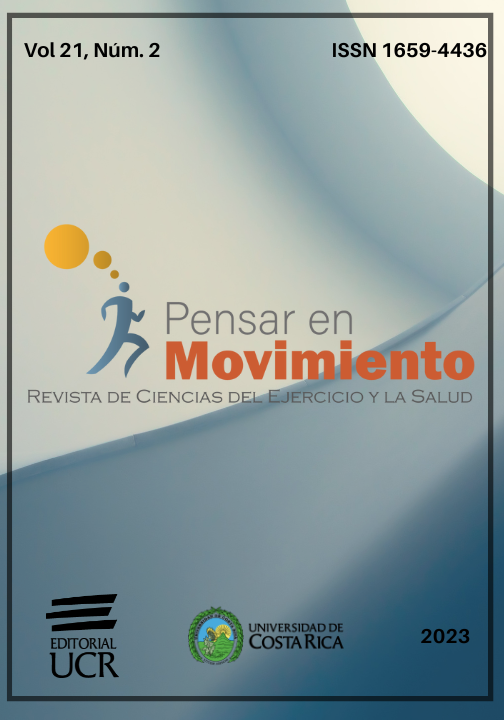Abstract
Jump height continues to be widely used to predict power in humans. Individual progress is often monitored on the basis of estimated power, but prediction equations are based on group data. The objective of the study was to show that vertical jump performance (VJP) and mechanical power are poorly associated, particularly within individuals. Two experiments are presented. First, 52 physically active male college students performed five maximal vertical jumps each. Second, three young male participants performed 50 maximal jumps each. Participants rested for 1 minute between jumps. VJP was calculated from kinematic data as peak body center of mass (BCOM) minus standing BCOM; peak power (PEAKPWR) was calculated from the vertical ground reaction force registered by a force plate, and average power (MEANPWR) during propulsion from the change in potential energy of BCOM. Regression analyses were performed using standardized VJP scores as the predictor variable and standardized power scores as the resulting variables, expecting an identity function of y = x (intercept = 0, slope = 1) and R2 = 1. In experiment 1, the model for zPEAKPWR R2 = 0.9707 (p < 0.0001) but slope (0.3452) ≠ 1 (p < 0.0001). The model for zMEANPWR R2 = 0.9239 (p < 0.0001); nevertheless, slope (0.4257) ≠ 1 (p < 0.0001). In experiment 2, all individual models for zPEAKPWR and zMEANPWR resulted in poor associations (R2 ≤ 0.21) and slopes ≠ 1 (p≤0.001). In conclusion, regression analysis for individuals, and even for groups, confirms that VJP is a poor predictor of mechanical power.
References
Aragón-Vargas, L.F. (2000). Evaluation of Four Vertical Jump Tests: Methodology, Reliability, Validity and Accuracy. Measurement in Physical Education and Exercise Science, 4(4), 215–228. https://doi.org/10.1207/S15327841MPEE0404_2
Aragón-Vargas, L. F., y González-Lutz, M. I. (2023a). Dataset for experiment 1 of A novel validation approach shows new, solid reasons why vertical jump height should not be used to predict leg power. Pensar en Movimiento: Revista de Ciencias del Ejercicio y la Salud, 21(2). https://doi.org/10.15517/pensarmov.v21i2.56206
Aragón-Vargas, L. F., y González-Lutz, M. I. (2023b). Dataset for experiment 2 of A novel validation approach shows new, solid reasons why vertical jump height should not be used to predict leg power. Pensar en Movimiento: Revista de Ciencias del Ejercicio y la Salud, 21(2). https://doi.org/10.15517/pensarmov.v21i2.56208
Aragón-Vargas, L.F., y Gross, M.M. (1997a). Kinesiological factors in vertical jump performance: Differences among individuals. Journal of Applied Biomechanics, 13(1), 24–44. https://doi.org/10.1123/jab.13.1.24
Aragón-Vargas, L.F., y Gross, M.M. (1997b). Kinesiological factors in vertical jump performance: Differences within individuals. Journal of Applied Biomechanics, 13(1), 45–65. https://doi.org/10.1123/jab.13.1.45
Bar-Or, O. (1987). The Wingate anaerobic test. An update on methodology, reliability and validity. Sports Medicine, 4(6), 381–394. https://doi.org/10.2165/00007256-198704060-00001
Barquero, J. F., y Salazar, W. (2020). Efecto agudo de los entrenamientos de fuerza, velocidad, pliometría y velocidad contra resistencia en la carrera de velocidad . Pensar en Movimiento: Revista de Ciencias del Ejercicio y la Salud, 18(2), e40315. https://doi.org/10.15517/pensarmov.v18i2.40315
Bosco, C., Luhtanen, P., y Komi, P.V. (1983). A simple method for measurement of mechanical power in jumping. European Journal of Applied Physiology and Occupational Physiology, 50(2), 273–282. https://doi.org/10.1007/BF00422166
Canavan, P. K., y Vescovi, J. D. (2004). Evaluation of Power Prediction Equations: Peak Vertical Jumping Power in Women. Medicine & Science in Sports & Exercise, 36(9), 1589–1593. https://doi.org/10.1249/01.MSS.0000139802.96395.ac
Del Coso, J. D., y Mora-Rodríguez, R. (2006). Validity of cycling peak power as measured by a short-sprint test versus the Wingate anaerobic test. Applied Physiology, Nutrition, and Metabolism = Physiologie Appliquee, Nutrition Et Metabolisme, 31(3), 186–189. https://doi.org/10.1139/h05-026
Harman, E., Rosenstein, M., Frykman, P., Rosenstein, R., y Kraemer, W. (1991). Estimation of Human Power Output from Vertical Jump. https://www.semanticscholar.org/paper/Estimation-of-Human-Power-Output-from-Vertical-Jump-Harman-Rosenstein/47eeda520e5a2595392064a2faaf93909323751e
Hatze, H. (1998). Validity and Reliability of Methods for Testing Vertical Jumping Performance. Journal of Applied Biomechanics, 14(2), 127–140. https://doi.org/10.1123/jab.14.2.127
Jiménez-Reyes, P., Samozino, P., Pareja-Blanco, F., Conceição, F., Cuadrado-Peñafiel, V., González-Badillo, J. J., y Morin, J.-B. (2017). Validity of a Simple Method for Measuring Force-Velocity-Power Profile in Countermovement Jump. International Journal of Sports Physiology and Performance, 12(1), 36–43. https://doi.org/10.1123/ijspp.2015-0484
Kirkendall, D. R., Gruber, J. J., y Johnson, R. E. (1987). Measurement and evaluation for physical educators. Human Kinetics. https://library.olympics.com/Default/doc/SYRACUSE/67952/measurement-and-evaluation-for-physical-educators-don-r-kirkendall-joseph-j-gruber-robert-e-johnson
Lara-Sánchez, A. J., Zagalaz, M. L., Berdejo-del-Fresno, D., y Martínez-López, E. J. (2011). Jump Peak Power Assessment Through Power Prediction Equations in Different Samples. The Journal of Strength & Conditioning Research, 25(7), 1957–1962. https://doi.org/10.1519/JSC.0b013e3181e06ef8
Mann, T. (2011). Mean response disregards the importance of individual variation. South African Journal of Sports Medicine, 23(1), 30. https://doi.org/10.17159/2078-516X/2011/v23i1a532
Mann, T. N., Lamberts, R. P., y Lambert, M. I. (2014). High responders and low responders: Factors associated with individual variation in response to standardized training. Sports Medicine, 44(8), 1113–1124. https://doi.org/10.1007/s40279-014-0197-3
Morin, J.-B., Jiménez-Reyes, P., Brughelli, M., y Samozino, P. (2019). When Jump Height is not a Good Indicator of Lower Limb Maximal Power Output: Theoretical Demonstration, Experimental Evidence and Practical Solutions. Sports Medicine, 49(7), 999–1006. https://doi.org/10.1007/s40279-019-01073-1
Rodríguez Zárate, N. M., Argothy Bucheli, R. E., Acero Jáuregui, J. A., Gómez Salazar, L., Menzel, H., y Cohen, D. D. (2018). Lineamiento de política pública en ciencias del deporte en Biomecánica. Coldeportes. https://acortar.link/Y8dpff
Samozino, P., Morin, J.-B., Hintzy, F., y Belli, A. (2008). A simple method for measuring force, velocity and power output during squat jump. Journal of Biomechanics, 41(14), 2940–2945. https://doi.org/10.1016/j.jbiomech.2008.07.028
Sayers, S. P., Harackiewicz, D. V., Harman, E. A., Frykman, P. N., y Rosenstein, M. T. (1999). Cross-validation of three jump power equations. Medicine & Science in Sports & Exercise, 31(4), 572–577. https://doi.org/10.1097/00005768-199904000-00013.
Tessier, J.-F., Basset, F.-A., Simoneau, M., y Teasdale, N. (2013). Lower-Limb Power cannot be Estimated Accurately from Vertical Jump Tests. Journal of Human Kinetics, 38(2013), 5–13. https://doi.org/10.2478/hukin-2013-0040
##plugins.facebook.comentarios##

This work is licensed under a Creative Commons Attribution-NonCommercial-ShareAlike 4.0 International License.
Copyright (c) 2023 Luis Fernando Aragón-Vargas, María Isabel González-Lutz







